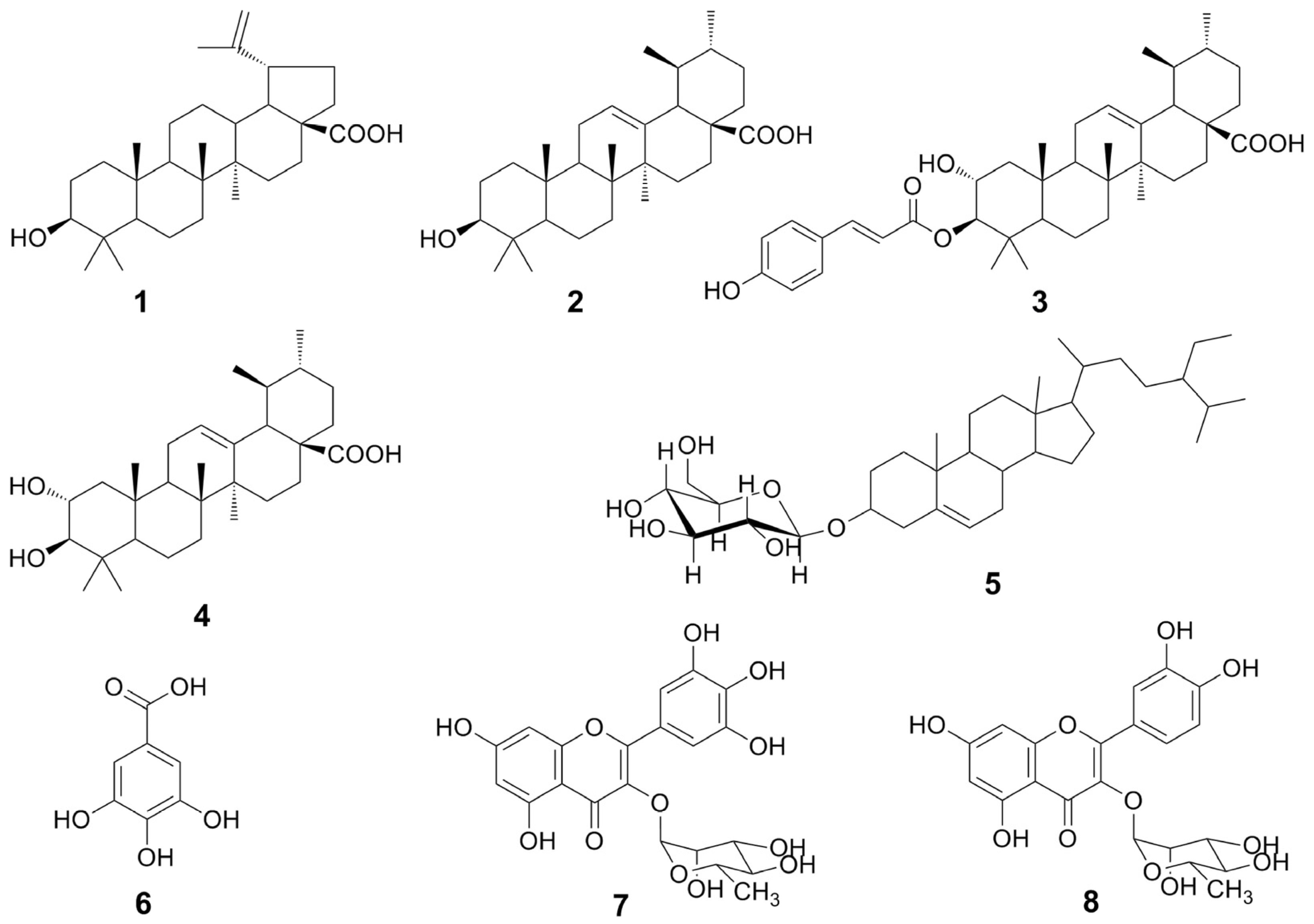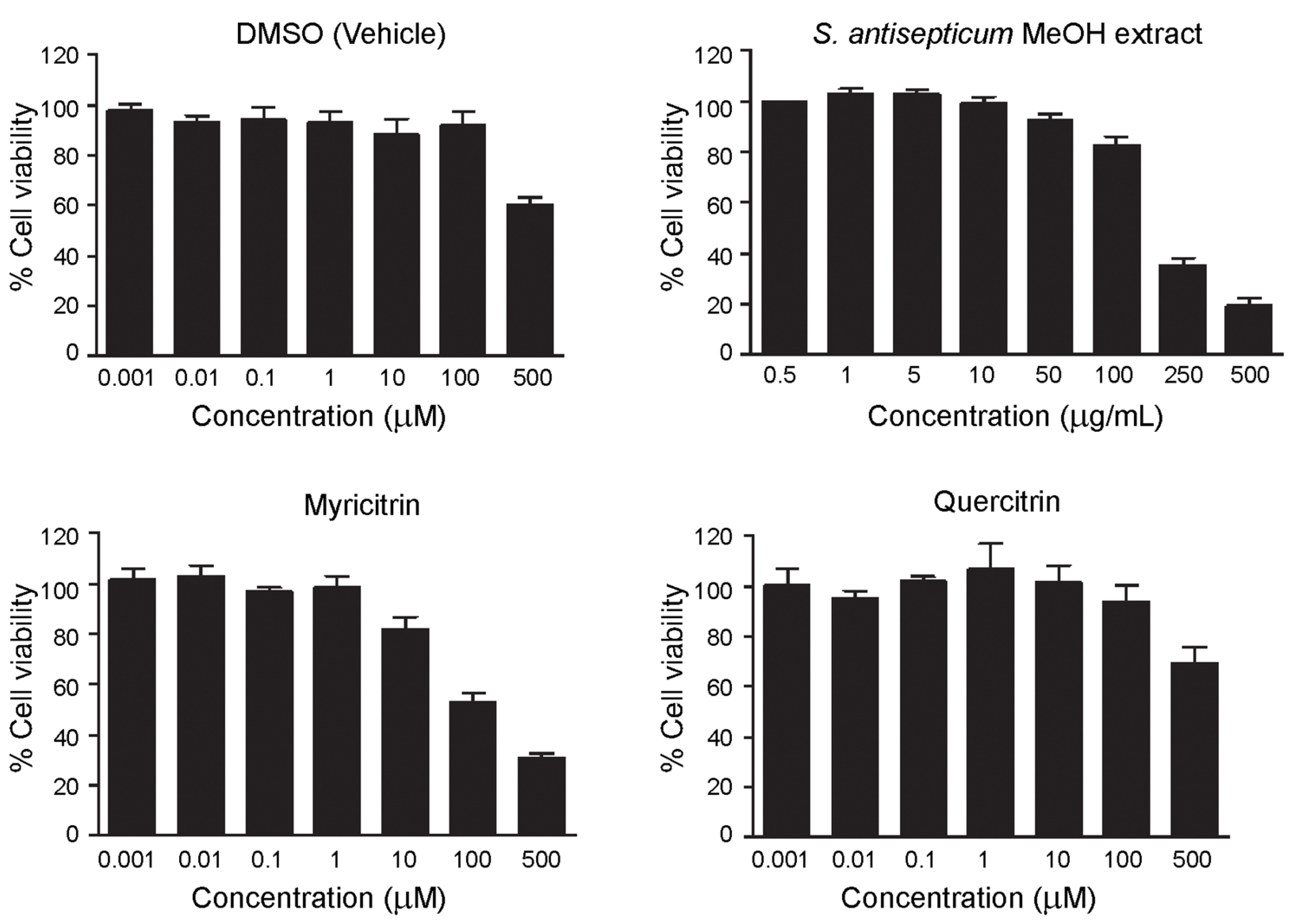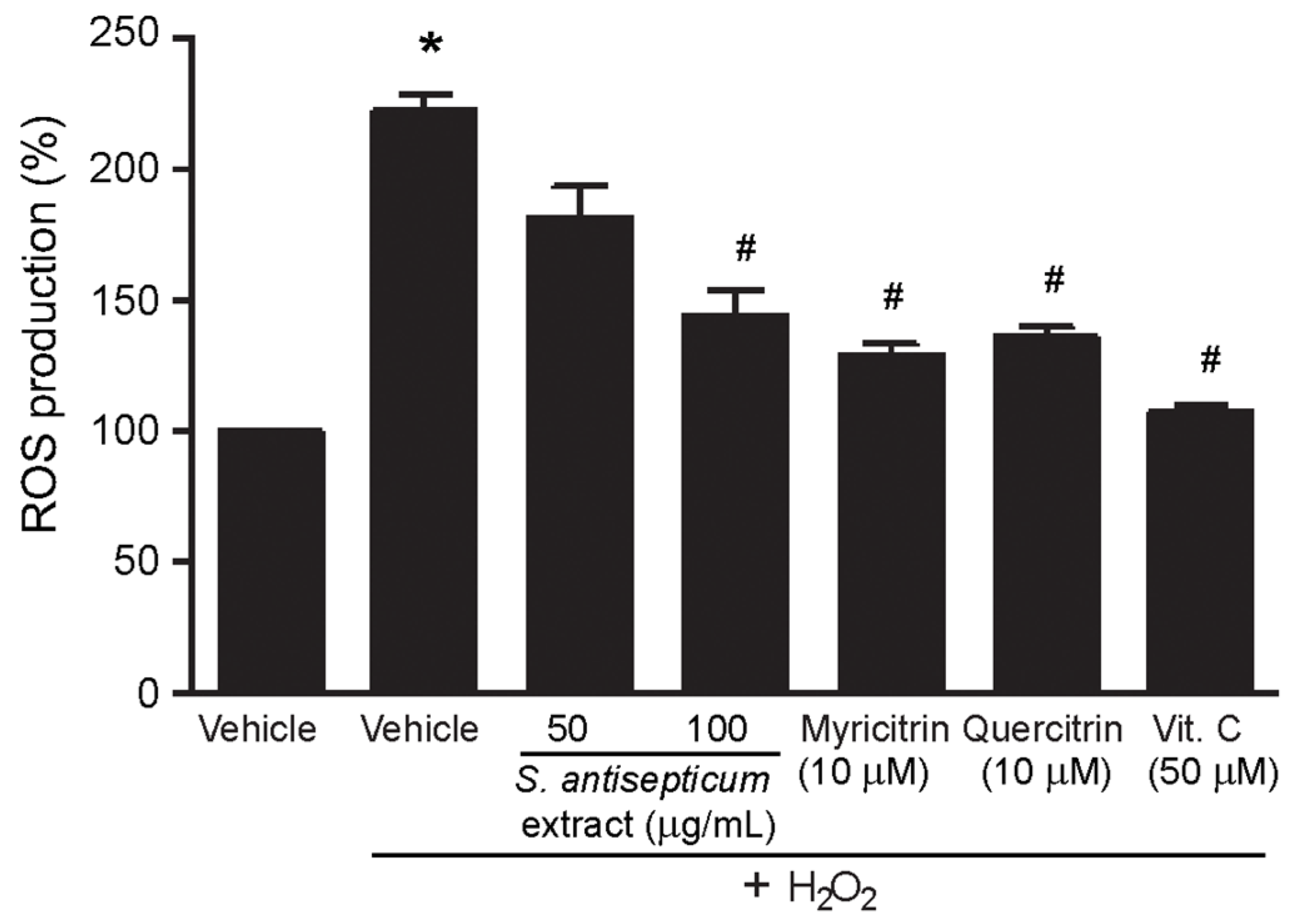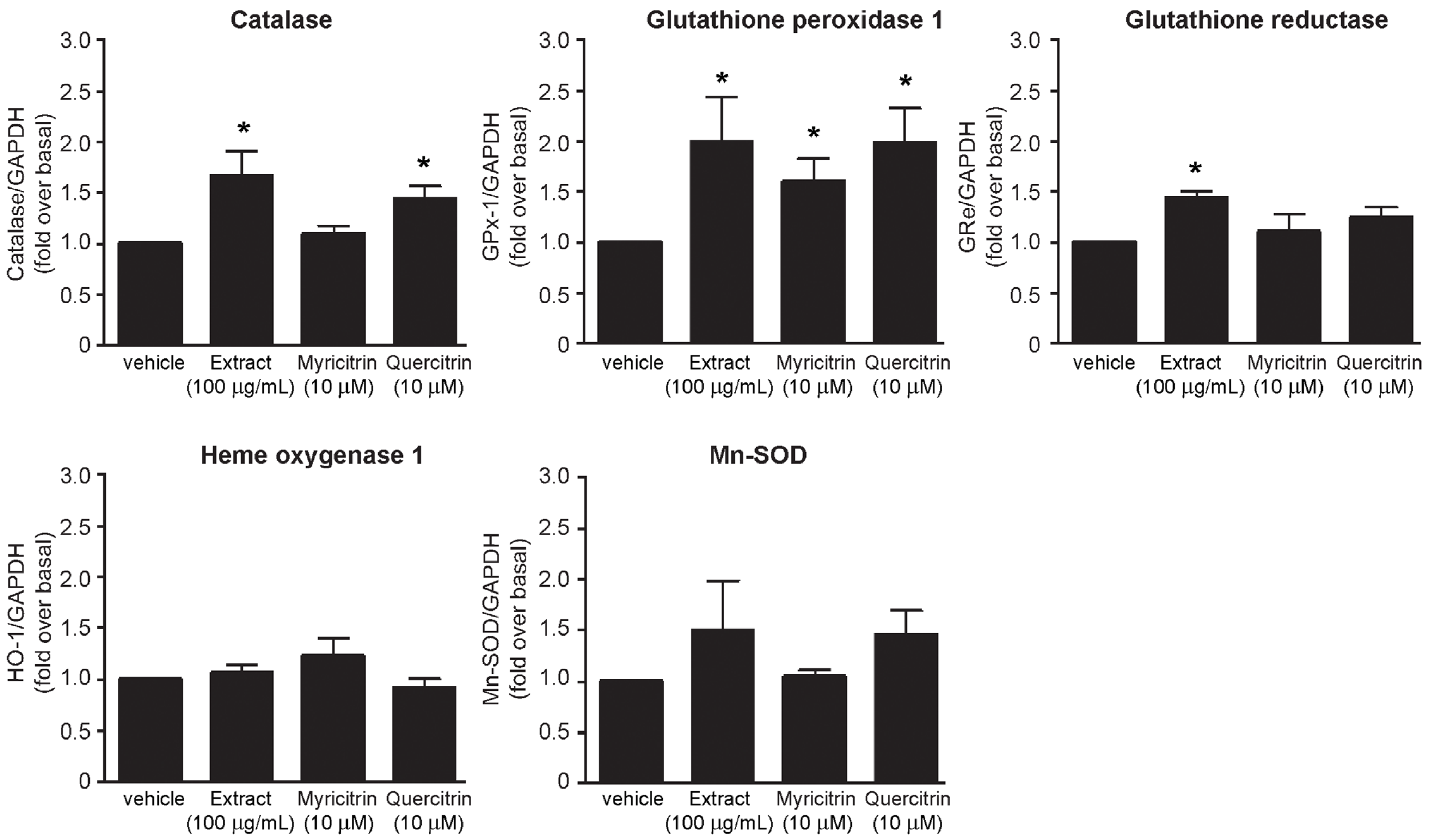Antioxidant and Anticholinesterase Activities of Extracts and Phytochemicals of Syzygium antisepticum Leaves
Abstract
1. Introduction
2. Results and Discussion
2.1. Bioassay-Guided Fractionation
2.2. Effects of Methanol Extract and Flavonoid Glycosides from S. antisepticum on Cell Viability of HEK-293 Cells
2.3. Effects of Methanol Extract and Flavonoid Glycosides from S. antisepticum on H2O2-Induced Intracellular ROS Production and mRNA Expression of Antioxidant Enzymes in HEK-293 Cells
3. Materials and Methods
3.1. General
3.2. Chemicals
3.3. Plant Materials
3.4. Extraction and Isolation
3.5. Anticholinesterase Assay
3.6. DPPH Radical-Scavenging Assay
3.7. Cell Culture
3.8. Determination of Cell Cytotoxicity by MTT Assay
3.9. Measurement of ROS Production in HEK-293 Cells
3.10. Determination of mRNA Expression
3.11. Statistical Analysis
4. Conclusions
Supplementary Materials
Author Contributions
Funding
Data Availability Statement
Acknowledgments
Conflicts of Interest
Sample Availability
References
- United Nations Population Fund (UNFPA) and HelpAge. Setting the Scene. In International Ageing in the Twenty-First Century: A Celebration and a Challenge; Pureprint Group: Uckfield, UK, 2012; pp. 19–27. [Google Scholar]
- Liguori, I.; Russo, G.; Curcio, F.; Bulli, G.; Aran, L.; Della-Morte, D.; Gargiulo, G.; Testa, G.; Cacciatore, F.; Bonaduce, D.; et al. Oxidative stress, aging, and diseases. Clin. Interv. Aging 2018, 13, 757–772. [Google Scholar] [CrossRef]
- Pizzino, G.; Irrera, N.; Cucinotta, M.; Pallio, G.; Mannino, F.; Arcoraci, V.; Squadrito, F.; Altavilla, D.; Bitto, A. Oxidative stress: Harms and benefits for human health. Oxid. Med. Cell. Longev. 2017, 2017, 8416763. [Google Scholar] [CrossRef]
- Lobo, V.; Patil, A.; Phatak, A.; Chandra, N. Free Radicals, Antioxidants and functional foods: Impact on human health. Phamacog. Rev. 2010, 4, 118–126. [Google Scholar] [CrossRef]
- Dos Santos, T.C.; Gomes, T.M.; Pinto, B.A.S.; Camara, A.L.; Paes, A.M.A. Naturally occurring acetylcholinesterase inhibitors and their potential use for Alzheimer’s disease therapy. Front. Pharmacol. 2018, 9, 1192. [Google Scholar] [CrossRef]
- Thakur, A.K.; Kamboj, P.; Goswami, K. Pathophysiology and management of Alzheimer’s disease: An overview. J. Anal. Pharm. Res. 2018, 7, 226–235. [Google Scholar] [CrossRef]
- Shabani, S.; Rabiei, Z.; Amini-Khoei, H. Exploring the multifaceted neuroprotective actions of gallic acid: A review. Int. J. Food Prop. 2020, 23, 736–752. [Google Scholar] [CrossRef]
- Olivares, D.; Deshpande, V.K.; Shi, Y.; Lahiri, D.K.; Greig, N.H.; Rogers, J.T.; Huang, X. N-methyl D-aspartate (NMDA) receptor antagonists and memantine treatment for Alzheimer’s disease, vascular dementia and Parkinson’s disease. Curr. Alzheimer Res. 2012, 9, 746–758. [Google Scholar] [CrossRef]
- Sukumaran, N.P.; Amalraj, A.; Gopi, S. Neuropharmacological and cognitive effects of Bacopa monnieri (L.) Wettst–A review on its mechanistic aspects. Complement. Ther. Med. 2019, 44, 68–82. [Google Scholar] [CrossRef]
- Matthews, D.G.; Caruso, M.; Murchison, C.F.; Zhu, J.Y.; Wright, K.M.; Harris, C.J.; Gray, N.E.; Quinn, J.F.; Soumyanath, A. Centella asiatica improves memory and promotes antioxidative signaling in 5XFAD mice. Antioxidants 2019, 8, 630. [Google Scholar] [CrossRef]
- Ahmed, T.; Gilani, A.H. Therapeutic potential of turmeric in Alzheimer’s disease: Curcumin or curcuminoids? Phytother. Res. 2014, 28, 517–525. [Google Scholar] [CrossRef]
- Senggunprai, L.; Kukongviriyapan, V.; Prawan, A.; Kukongviriyapan, U. Consumption of Syzygium gratum promotes the antioxidant defense system in mice. Plant Foods Hum. Nutr. 2010, 65, 403–409. [Google Scholar] [CrossRef]
- Kukongviriyapan, U.; Luangaram, S.; Leekhaosoong, K.; Kukongviriyapan, V.; Preeprame, S. Antioxidant and vascular protective activities of Cratoxylum formosum, Syzygium gratum and Limnophila aromatica. Biol. Pharm. Bull. 2007, 30, 661–666. [Google Scholar] [CrossRef]
- Stewart, P.; Boonsiri, P.; Puthong, S.; Rojpibulstit, P. Antioxidant activity and ultrastructural changes in gastric cancer cell lines induced by Northeastern Thai edible folk plant extracts. BMC Complement. Altern. Med. 2013, 13, 60. [Google Scholar] [CrossRef] [PubMed]
- Woraratphoka, J.; Intarapichet, K.; Indrapichate, K. Antioxidant activity and cytotoxicity of six selected, regional, Thai vegetables. Am Euras. J. Toxicol. Sci. 2012, 4, 108–117. [Google Scholar]
- Thummajitasakul, S.; Tumchalee, L.; Koolwong, S.; Deetae, P.; Kaewsri, W.; Lertsiri, S. Antioxidant and antibacterial potentials of some Thai native plant extracts. Int. Food Res. J. 2014, 21, 2393–2398. [Google Scholar]
- Bureemas, J.; Kukongviriyapan, V.; Kukongviriyapan, U.; Senggunprai, L.; Jetsrisuparb, A. Effects of Syzygium gratum on antioxidant system in β-thalassemia/Hb E patients. KKU Res. J. 2007, 7, 15–21. [Google Scholar] [CrossRef]
- Aung, E.E.; Kristanti, A.N.; Aminah, N.S.; Takaya, Y.; Ramadhan, R. Plant description, phytochemical constituents and bioactivities of Syzygium genus: A review. Open Chem. 2020, 18, 1256–1281. [Google Scholar] [CrossRef]
- Sobeh, M.; Esmat, A.; Petruk, G.; Abdelfattah, M.A.O.; Dmirieh, M.; Monti, D.M.; Abdel-Naim, A.B.; Wink, M. Phenolic compounds from Syzygium jambos (Myrtaceae) exhibit distinct antioxidant and hepatoprotective activities in vivo. J. Funct. Foods 2018, 41, 223–231. [Google Scholar] [CrossRef]
- Sobeh, M.; Petruk, G.; Osman, S.; El-Raey, M.A.; Imbimbo, P.; Monti, D.M.; Wink, M. Isolation of myricitrin and 3,5-di-o-methyl from Syzygium samarangense and evaluation of their involvement in protecting keratinocytes against oxidative stress via activation of the Nrf-2 Pathway. Molecules 2019, 24, 1839. [Google Scholar] [CrossRef]
- Arumugam, B.; Palanisamy, U.D.; Chua, K.H.; Kuppusamy, U.R. Protective effect of myricetin derivatives from Syzygium malaccense against hydrogen peroxide-induced stress in ARPE-19 cells. Mol. Vis. 2019, 25, 47–59. [Google Scholar]
- Shamsudin, K.J.; Phan, C.S.; Kulip, J.; Hatai, K.; Vairappan, C.S.; Kamada, T. Leucoxenols A and B, two new phenolics from Bornean medicinal plant Syzygium leucoxylon. J. Asian Nat. Prod. Res. 2018, 21, 435–441. [Google Scholar] [CrossRef]
- Peng, C.; Bodenhausen, G.; Qiu, S.; Fong, H.; Farnsworth, N.; Yuan, S.; Zheng, C. Computer-assisted structure elucidation: Application of CISOC-SES to the resonance assignment and structure generation of betulinic acid. Magn. Reson. Chem. 1998, 36, 267–278. [Google Scholar] [CrossRef]
- Sholichin, M.; Yamasaki, K.; Kasai, R.; Tanaka, O. 13C nuclear magnetic resonance of lupane-type triterpenes, lupeol, betulin and betulinic acid. Chem. Pharm. Bull. 1980, 28, 1006–1008. [Google Scholar] [CrossRef]
- Siddiqui, S.; Hafeez, F.; Begum, S.; Siddiqui, B.S. Oleanderol, a new pentacyclic triterpene from the leaves of Nerium oleander. J. Nat. Prod. 1988, 51, 229–233. [Google Scholar] [CrossRef]
- Jang, D.S.; Kim, J.M.; Lee, G.Y.; Kim, J.; Kim, J.S. Ursane-type triterpenoids from the aerial parts of Potentilla discolor. Agric. Chem. Biotechnol. 2006, 49, 48–50. [Google Scholar]
- Lee, T.H.; Juang, S.H.; Hsu, F.L.; Wu, C.Y. Triterpene acids from the leaves of Planchonella duclitan. J. Chin. Chem. Soc. 2005, 52, 1275–1280. [Google Scholar] [CrossRef]
- Faizi, S.; Ali, M.; Saleem, R.; Irfanullah; Bibi, S. Complete 1H and 13C NMR assignments of stigma-5-en-3-O-β-glucosides and its acetyl derivative. Magn. Reson. Chem. 2001, 39, 399–405. [Google Scholar] [CrossRef]
- Said, A.; Hawas, U.W.; Nofal, S.M.; Rashed, K.; Huefner, A. Pharmaco-chemical studies on the aqueous methanolic extract of Diospyros lotus Leaves. Res. J. Phytochem. 2009, 3, 1–10. [Google Scholar]
- Sidana, J.; Neeradi, D.; Choudhary, A.; Singh, S.; Foley, W.J.; Singh, I.P. Antileishmanial polyphenols from Corymbia maculate. J. Chem. Sci. 2013, 125, 765–775. [Google Scholar] [CrossRef]
- Hopia, A.; Heinonen, M. Antioxidant activity of flavonol aglycones and their glycosides in methyl linoleate. J. Am. Oil Chem. Soc. 1999, 76, 139–144. [Google Scholar] [CrossRef]
- Chung, Y.K.; Heo, H.J.; Kim, E.K.; Kim, H.K.; Huh, T.L.; Lim, Y.; Kim, S.K.; Shin, D.H. Inhibitory effect of ursolic acid purified from Origanum majorana L. on the acetylcholinesterase. Mol. Cells 2001, 11, 137–143. [Google Scholar] [PubMed]
- Loesche, A.; Köwitsch, A.; Lucas, S.D.; Al-Halabi, Z.; Sippl, W.; Al-Harrasi, A.; Csuk, R. Ursolic and oleanolic acid derivatives with cholinesterase inhibiting potential. Bioorg. Chem. 2019, 85, 23–32. [Google Scholar] [CrossRef]
- Kim, J.H.; Choi, G.N.; Kwak, J.H.; Jeong, H.R.; Jeong, C.H.; Heo, H.J. Neuronal cell protection and acetylcholinesterase inhibitory effect of the phenolics in chestnut inner skin. Food Sci. Biotechnol. 2011, 20, 311–318. [Google Scholar] [CrossRef]
- Liang, W.; Zhao, X.; Feng, J.; Song, F.; Pan, Y. Ursolic acid attenuates beta-amyloid-induced memory impairment in mice. Arq. Neuropsiquiatr. 2016, 74, 482–488. [Google Scholar] [CrossRef][Green Version]
- Habtemariam, S. Antioxidant and anti-inflammatory mechanisms of neuroprotection by ursolic acid: Addressing brain injury, cerebral ischemia, cognition deficit, anxiety, and depression. Oxid. Med. Cell. Longev. 2019, 2019, 18512048. [Google Scholar] [CrossRef]
- Lu, J.; Zheng, Y.L.; Wu, D.M.; Luo, L.; Sun, D.X.; Shan, Q. Ursolic acid ameliorates cognition deficits and attenuates oxidative damage in the brain of senescent mice induced by D-galactose. Biochem. Pharmacol. 2007, 74, 1078–1090. [Google Scholar] [CrossRef]
- Youn, K.; Jun, M. Inhibitory effects of key compounds isolated from Corni fructuson BACE1 activity. Phytother. Res. 2012, 26, 1714–1718. [Google Scholar] [CrossRef] [PubMed]
- Ogunsuyi, O.B.; Oboh, G.; Oluokun, O.O.; Ademiluyi, A.O.; Ogunruku, O.O. Gallic acid protects against neurochemical alterations in transgenic Drosophila model of Alzheimer’s disease. Adv. Tradit. Med. 2020, 20, 89–98. [Google Scholar] [CrossRef]
- Hajipour, S.; Sarkaki, A.R.; Farbood, Y.; Eidi, A.; Mortazavi, P.; Valizadeh, Z. Effect of gallic acid on dementia type of Alzheimer disease in rats: Electrophysiological and histological studies. Basic Clin. Neurosci. 2016, 7, 97–106. [Google Scholar] [CrossRef]
- Yu, M.; Chen, X.; Liu, J.; Ma, Q.; Zhuo, Z.; Chen, H.; Zhou, L.; Yang, S.; Zheng, L.; Ning, C.; et al. Gallic acid disruption of Aβ1–42 aggregation rescues cognitive decline of APP/PS1 double transgenic mouse. Neurobiol. Dis. 2019, 124, 67–80. [Google Scholar] [CrossRef] [PubMed]
- Anantachoke, N.; Kitphati, W.; Mangmool, S.; Bunyapraphatsara, N. Polyphenolic compounds and antioxidant activities of the leaves of Glochidion hypoleucum. Nat. Prod. Commun. 2015, 10, 479–482. [Google Scholar] [CrossRef]
- Li, X.; Jiang, Q.; Wang, T.; Liu, J.; Chen, D. Comparison of the antioxidant effects of quercitrin and isoquercitrin: Understanding the role of the 6″-OH group. Molecules 2016, 21, 1246. [Google Scholar] [CrossRef]
- Hong, C.O.; Lee, H.A.; Rhee, C.H.; Choung, S.Y.; Lee, K.W. Separation of the antioxidant compound quercitrin from Lindera obtusiloba Blume and its antimelanogenic effect on B16F10 melanoma cells. Biosci. Biotechnol. Biochem. 2013, 77, 58–64. [Google Scholar] [CrossRef]
- Ham, Y.M.; Yoon, W.J.; Park, S.Y.; Song, G.P.; Jung, Y.H.; Jeon, Y.J.; Kang, S.M.; Kim, K.N. Quercitrin protects against oxidative stress-induced injury in lung fibroblast cells via up-regulation of Bcl-xL. J. Funct. Foods. 2012, 4, 253–262. [Google Scholar] [CrossRef]
- Anantachoke, N.; Lomarat, P.; Praserttirachai, W.; Khammanit, R.; Mangmool, S. Thai fruits exhibit antioxidant activity and induction of antioxidant enzymes in HEK-293 cells. Evid. Based. Complement. Alternat. Med. 2016, 2016. [Google Scholar] [CrossRef] [PubMed]
- Tanticharakunsiri, W.; Mangmool, S.; Wongsariya, K.; Ochaikul, D. Characteristics and upregulation of antioxidant enzymes of kitchen mint and oolong tea kombucha beverages. J. Food Biochem. 2021, 45, e13574. [Google Scholar] [CrossRef] [PubMed]
- Jaisupa, N.; Moongkarndi, P.; Lomarat, P.; Samer, J.; Tunrungtavee, V.; Muangpaisan, W.; Mangmool, S. Mangosteen peel extract exhibits cellular antioxidant activity by induction of catalase and heme oxygenase-1 mRNA expression. J. Food. Biochem. 2018, 42, e12511. [Google Scholar] [CrossRef]
- Fridovich, I. Superoxide radical and superoxide dismutase. Annu. Rev. Biochem. 1995, 64, 97–112. [Google Scholar] [CrossRef]
- Arumugam, B.; Palanisamy, U.D.; Chua, K.H.; Kuppusamy, U.R. Amelioration of hyperglycemia-induced oxidative damage in ARPE-19 cells by myricetin derivatives isolated from Syzygium malaccense. J. Funct. Foods 2020, 67, 103844. [Google Scholar] [CrossRef]
- Yang, H.M.; Ham, Y.M.; Yoon, W.J.; Roh, S.W.; Jeon, Y.J.; Oda, T.; Kang, S.M.; Kang, M.C.; Kim, E.A.; Kim, D.; et al. Quercitrin protects against ultraviolet B-induced cell death in vitro and in an in vivo zebrafish model. J. Photochem. Photobiol. B 2012, 114, 126–131. [Google Scholar] [CrossRef] [PubMed]
- Chow, J.M.; Shen, S.C.; Huan, S.K.; Lin, H.Y.; Chen, Y.C. Quercetin, but not rutin and quercitrin, prevention of H2O2-induced apoptosis via anti-oxidant activity and heme oxygenase 1 gene expression in macrophages. Biochem. Pharmacol. 2005, 69, 1839–1851. [Google Scholar] [CrossRef] [PubMed]
- Ellman, G.L.; Courtney, K.D.; Andres, V.; Featherstone, R.M. A new and rapid colorimetric determination of acetylcholinesterase activity. Biochem. Pharmacol. 1961, 7, 88–95. [Google Scholar] [CrossRef]
- Rhee, I.K.; Meent, M.V.; Ingkaninan, K.; Verpoorte, R. Screening for acetylcholinesterase inhibitors from Amaryllidaceae using sílica gel thin-layer chromatography in combination with bioactivity staining. J. Chromatogr. A 2001, 915, 217–223. [Google Scholar] [CrossRef]
- Khammanit, R.; Lomarat, P.; Anantachoke, N.; Sato, V.H.; Ungsurungsie, M.; Mangmool, S. Inhibition of oxidative stress through the induction of antioxidant enzymes of pigmented rice bran in HEK-293 cells. Nat. Prod. Commun. 2017, 12, 1107–1110. [Google Scholar] [CrossRef]




| Compounds | DPPH Radical Scavenging | Anticholinesterase | ||
|---|---|---|---|---|
| % Inhibition | IC50 (µM) | % Inhibition | IC50 (µM) | |
| Hexane extract | 7.2 ± 2.33 1 | ND | ND 4 | ND |
| Ethyl acetate extract | 68.68 ± 1.42 1 | ND | ND 4 | ND |
| Methanol extract | 68.72 ± 0.32 1 | ND | 61.90 ± 0.08 3 | ND |
| Betulinic acid (1) | 15.90 ± 0.87 2 | ND | 39.95 ± 1.53 2,5 | ND |
| Ursolic acid (2) | 12.69 ± 1.33 2 | ND | 73.39 ± 1.32 2,5 | 159.32 ± 1.34 5 |
| Jacoumaric acid (3) | 19.40 ± 2.51 2 | ND | 29.73 ± 3.12 2,5 | ND |
| Corosolic acid (4) | 3.61 ± 0.63 2 | ND | 11.18 ± 0.30 2,6 | ND |
| Daucosterol (5) | 4.11 ± 0.81 2 | ND | 5.53 ± 1.47 2,6 | ND |
| Gallic acid (6) | 95.80 ± 0.32 2 | 14.46 ± 0.29 | 81.64 ± 0.29 2,6 | 161.06 ± 9.52 6 |
| Myricitrin (7) | 95.27 ± 0.45 2 | 31.01 ± 0.90 | 10.91 ± 1.69 2,6 | ND |
| Quercitrin (8) | 93.16 ± 0.11 2 | 38.34 ± 0.74 | 10.21 ± 1.26 2,6 | ND |
| Ascorbic acid (Vitamin C) | ND | 59.73 ± 2.73 | ND | ND |
| Trolox | ND | 50.10 ± 3.56 | ND | ND |
| Galantamine 5 | ND | ND | ND | 14.76 ± 0.63 5 |
| Galantamine 6 | ND | ND | ND | 6.02 ± 0.42 6 |
| Gene Specific Primers | Sequences | |
|---|---|---|
| Glutathione peroxidase-1 (GPx-1) | Sense Antisense | 5′-ctcttcgagaagtgcgaggt-3′ 5′-tcgatgtcaatggtctggaa-3′ |
| Catalase | Sense Antisense | 5′-gcagatacctgtgaactgtc-3′ 5′-gtagaatgtccgcacctgag-3′ |
| Heme oxygenase-1 (HO-1) | Sense Antisense | 5′-caggcagagaatgctgag-3′ 5′-gcttcacatagcgctgca-3′ |
| Manganese superoxide dismutase (Mn-SOD) | Sense Antisense | 5′-gcacattaacgcgcagatca-3′ 5′-agcctccagcaactctcctt-3′ |
| Glutathione reductase (GRe) | Sense Antisense | 5′-cagtgggactcacggaagat-3′ 5′-ttcactgcaacagcaaaacc-3′ |
| Glyceraldehyde 3-phosphate dehydrogenase (GAPDH) | Sense Antisense | 5′-cgagatccctccaaaatcaa-3′ 5′-gtcttctgggtggcagtgat-3′ |
Publisher’s Note: MDPI stays neutral with regard to jurisdictional claims in published maps and institutional affiliations. |
© 2021 by the authors. Licensee MDPI, Basel, Switzerland. This article is an open access article distributed under the terms and conditions of the Creative Commons Attribution (CC BY) license (https://creativecommons.org/licenses/by/4.0/).
Share and Cite
Mangmool, S.; Kunpukpong, I.; Kitphati, W.; Anantachoke, N. Antioxidant and Anticholinesterase Activities of Extracts and Phytochemicals of Syzygium antisepticum Leaves. Molecules 2021, 26, 3295. https://doi.org/10.3390/molecules26113295
Mangmool S, Kunpukpong I, Kitphati W, Anantachoke N. Antioxidant and Anticholinesterase Activities of Extracts and Phytochemicals of Syzygium antisepticum Leaves. Molecules. 2021; 26(11):3295. https://doi.org/10.3390/molecules26113295
Chicago/Turabian StyleMangmool, Supachoke, Issaree Kunpukpong, Worawan Kitphati, and Natthinee Anantachoke. 2021. "Antioxidant and Anticholinesterase Activities of Extracts and Phytochemicals of Syzygium antisepticum Leaves" Molecules 26, no. 11: 3295. https://doi.org/10.3390/molecules26113295
APA StyleMangmool, S., Kunpukpong, I., Kitphati, W., & Anantachoke, N. (2021). Antioxidant and Anticholinesterase Activities of Extracts and Phytochemicals of Syzygium antisepticum Leaves. Molecules, 26(11), 3295. https://doi.org/10.3390/molecules26113295







